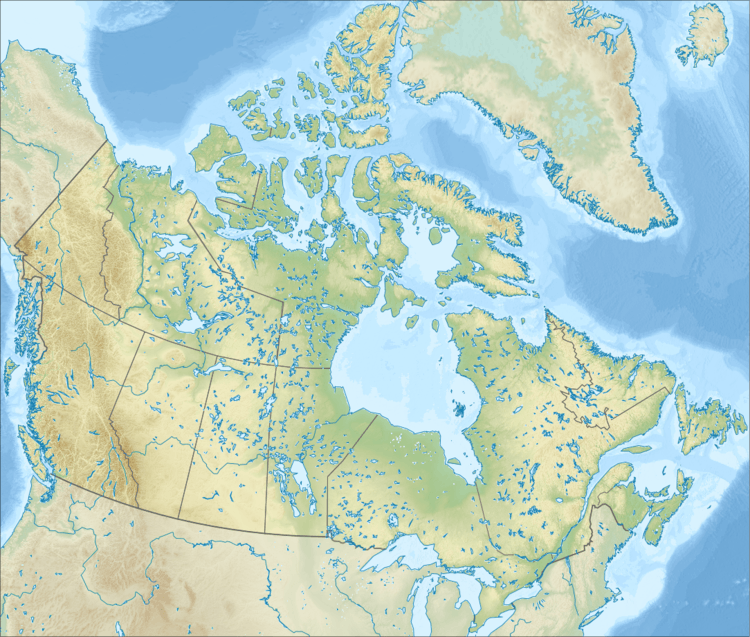Nigel Peak
Nigel Peak is a 3,211-metre (10,535-foot) mountain summit located on the shared border of Banff National Park and Jasper National Park, in the Canadian Rockies of Alberta, Canada. Nigel has two peaks, the north summit is the highest point. The nearest higher peak is Mount Athabasca, 6.4 km (4.0 mi) to the south-southwest.[5] Nigel Peak is situated immediately north of Sunwapta Pass and can be seen from the Icefields Parkway and from Athabasca Glacier.
| Nigel Peak | |
|---|---|
 Nigel Peak (west aspect) | |
| Highest point | |
| Elevation | 3,211 m (10,535 ft) [1] |
| Prominence | 611 m (2,005 ft) [1] |
| Parent peak | Sunwapta Peak (3315 m)[1] |
| Listing | Mountains of Alberta |
| Coordinates | 52°14′22″N 117°10′18″W [2] |
| Geography | |
 Nigel Peak Location of Nigel Peak in Alberta  Nigel Peak Nigel Peak (Canada) | |
| Location | Alberta, Canada |
| Parent range | Canadian Rockies |
| Topo map | NTS 83C/03[2] |
| Geology | |
| Type of rock | Sedimentary |
| Climbing | |
| First ascent | 1919 by Interprovincial Boundary Commission[3] |
| Easiest route | Scramble[4] |
History
Nigel Vavasour was a packer who accompanied J. Norman Collie and Hugh Stutfield to the Columbia Icefield area in 1897. The mountain was named by the mountaineers during an 1898 sheep hunt with Nigel.[3] The mountain was officially named Nigel Peak in 1935.[2] The first ascent of the mountain was made in 1919 by the Interprovincial Boundary Commission.
Geology
Like other mountains in Banff Park, Nigel Peak is composed of sedimentary rock laid down from the Precambrian to Jurassic periods.[6] Formed in shallow seas, this sedimentary rock was pushed east and over the top of younger rock during the Laramide orogeny.[7]

Climate
Based on the Köppen climate classification, Nigel Peak is located in a subarctic climate with cold, snowy winters, and mild summers.[8] Temperatures can drop below -20 °C with wind chill factors below -30 °C. Precipitation runoff from Nigel Peak drains south into the North Saskatchewan River, and north into the Sunwapta River which is a tributary of the Athabasca River.
References
- "Nigel Peak". Bivouac.com. Retrieved 2018-10-16.
- "Nigel Peak". Geographical Names Data Base. Natural Resources Canada. Retrieved 2018-10-16.
- "Nigel Peak". PeakFinder.com. Retrieved 2019-09-21.
- Kane, Alan (1999). "Nigel Peak". Scrambles in the Canadian Rockies. Calgary: Rocky Mountain Books. pp. 307–308. ISBN 0-921102-67-4.
- "Nigel Peak, Alberta". Peakbagger.com. Retrieved 2019-09-21.
- Belyea, Helen R. (1960). The Story of the Mountains in Banff National Park (PDF). parkscanadahistory.com (Report). Ottawa: Geological Survey of Canada. Archived (PDF) from the original on 2015-10-02. Retrieved 2019-09-13.
- Gadd, Ben (2008). Geology of the Rocky Mountains and Columbias.
- Peel, M. C.; Finlayson, B. L. & McMahon, T. A. (2007). "Updated world map of the Köppen−Geiger climate classification". Hydrol. Earth Syst. Sci. 11: 1633–1644. ISSN 1027-5606.
External links
- Nigel Peak Weather forecast
- Parks Canada web site: Jasper National Park
- Parks Canada web site: Banff National Park
- Nigel Peak from Tangle Ridge: Flickr photo